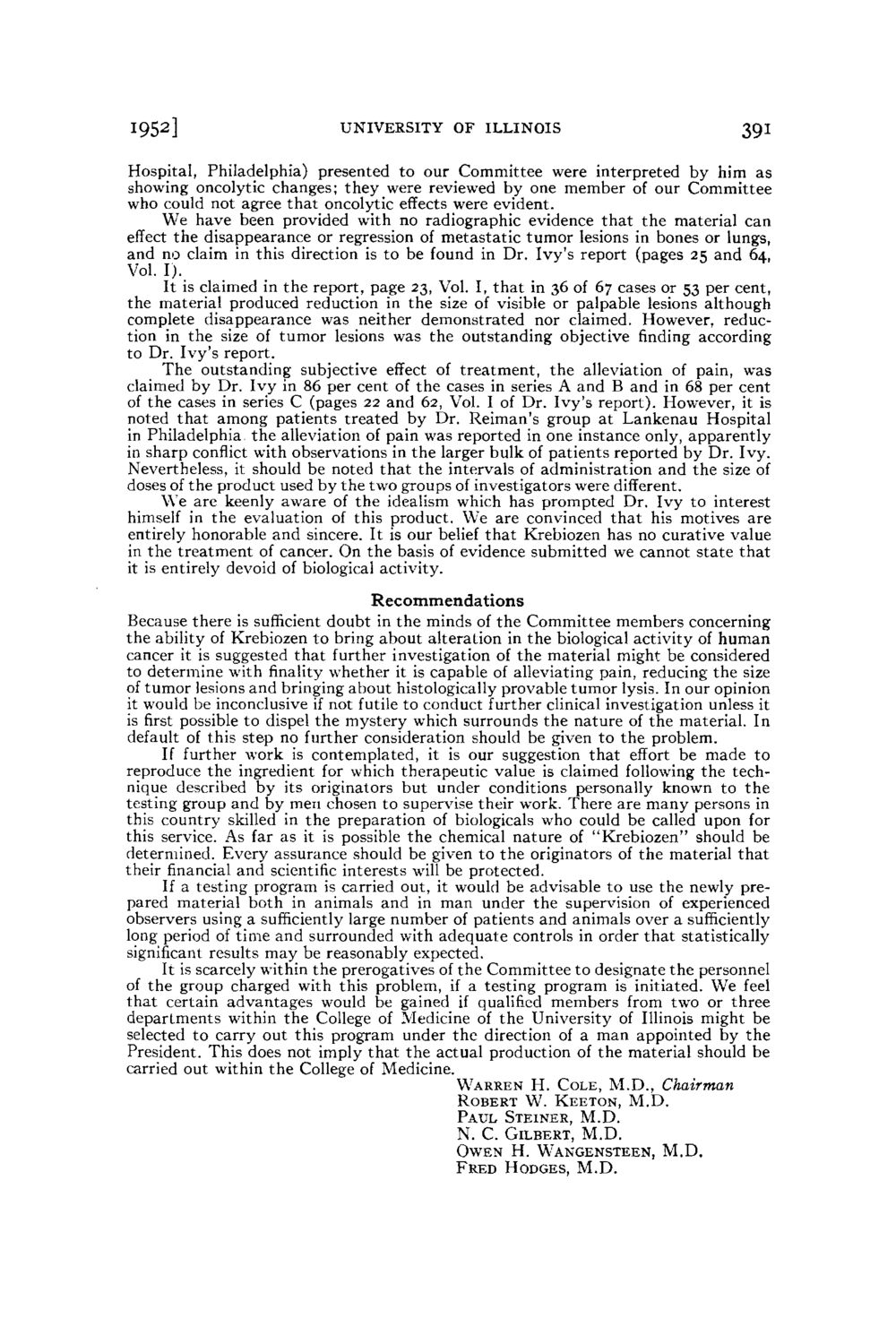| |
| |
Caption: Board of Trustees Minutes - 1954
This is a reduced-resolution page image for fast online browsing.

EXTRACTED TEXT FROM PAGE:
1952] UNIVERSITY OF ILLINOIS 391 Hospital, Philadelphia) presented to our Committee were interpreted by him as showing oncolytic changes; they were reviewed by one member of our Committee who could not agree that oncolytic effects were evident. We have been provided with no radiographic evidence that the material can effect the disappearance or regression of metastatic tumor lesions in bones or lungs, and no claim in this direction is to be found in Dr. Ivy's report (pages 25 and 64, Vol. I). It is claimed in the report, page 23, Vol. I, that in 36 of 67 cases or 53 per cent, the material produced reduction in the size of visible or palpable lesions although complete disappearance was neither demonstrated nor claimed. However, reduction in the size of tumor lesions was the outstanding objective finding according to Dr. Ivy's report. The outstanding subjective effect of treatment, the alleviation of pain, was claimed by Dr. Ivy in 86 per cent of the cases in series A and B and in 68 per cent of the cases in series C (pages 22 and 62, Vol. I of Dr. Ivy's report). However, it is noted that among patients treated by Dr. Reiman's group at Lankenau Hospital in Philadelphia, the alleviation of pain was reported in one instance only, apparently in sharp conflict with observations in the larger bulk of patients reported by Dr. Ivy. Nevertheless, it should be noted that the intervals of administration and the size of doses of the product used by the two groups of investigators were different. We are keenly aware of the idealism which has prompted Dr. Ivy to interest himself in the evaluation of this product. We are convinced that his motives are entirely honorable and sincere. It is our belief that Krebiozen has no curative value in the treatment of cancer. On the basis of evidence submitted we cannot state that it is entirely devoid of biological activity. Recommendations Because there is sufficient doubt in the minds of the Committee members concerning the ability of Krebiozen to bring about alteration in the biological activity of human cancer it is suggested that further investigation of the material might be considered to determine with finality whether it is capable of alleviating pain, reducing the size of tumor lesions and bringing about histologically provable tumor lysis. In our opinion it would be inconclusive if not futile to conduct further clinical investigation unless it is first possible to dispel the mystery which surrounds the nature of the material. In default of this step no further consideration should be given to the problem. If further work is contemplated, it is our suggestion that effort be made to reproduce the ingredient for which therapeutic value is claimed following the technique described by its originators but under conditions personally known to the testing group and by men chosen to supervise their work. There are many persons in this country skilled in the preparation of biologicals who could be called upon for this service. As far as it is possible the chemical nature of "Krebiozen" should be determined. Every assurance should be given to the originators of the material that their financial and scientific interests will be protected. If a testing program is carried out, it would be advisable to use the newly prepared material both in animals and in man under the supervision of experienced observers using a sufficiently large number of patients and animals over a sufficiently long period of time and surrounded with adequate controls in order that statistically significant results may be reasonably expected. It is scarcely within the prerogatives of the Committee to designate the personnel of the group charged with this problem, if a testing program is initiated. We feel that certain advantages would be gained if qualified members from two or three departments within the College of Medicine of the University of Illinois might be selected to carry out this program under the direction of a man appointed by the President. This does not imply that the actual production of the material should be carried out within the College of Medicine. W A R R E N H. COLE, M.D., Chairman ROBERT W. K E E T O N , M.D. P A U L STEINER, M.D. N. C. GILBERT, M.D. O W E N H. WANGENSTEEN, M.D, F R E D HODGES, M.D.
| |